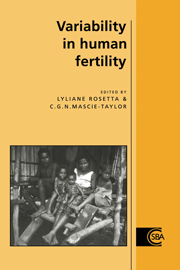Book contents
- Frontmatter
- Contents
- List of contributors
- 1 Introduction: the biological anthropological approach
- PART I HORMONAL ASPECTS OF FERTILITY REGULATION
- PART II INTERPOPULATION VARIABILITY
- 5 Age and developmental effects on human ovarian function
- 6 Non-pathological source of variability infertility: between/within subjects and between populations
- 7 The relationship between disease and subfecundity
- PART III METABOLIC AND ENERGETIC ASPECTS OF REGULATION
- Index
6 - Non-pathological source of variability infertility: between/within subjects and between populations
Published online by Cambridge University Press: 03 February 2010
- Frontmatter
- Contents
- List of contributors
- 1 Introduction: the biological anthropological approach
- PART I HORMONAL ASPECTS OF FERTILITY REGULATION
- PART II INTERPOPULATION VARIABILITY
- 5 Age and developmental effects on human ovarian function
- 6 Non-pathological source of variability infertility: between/within subjects and between populations
- 7 The relationship between disease and subfecundity
- PART III METABOLIC AND ENERGETIC ASPECTS OF REGULATION
- Index
Summary
Introduction
For a long time the approach of biological anthropology has been restricted to observational surveys based on questionnaires with a concomitant limitation to the measurement of variables like the mean age at puberty or the mean duration of post-partum amenorrhea. The quality of data collected by retrospective and/or cross-sectional surveys has been improved with prospective surveys and large sample size. The use of more sophisticated statistical analysis based on probabilities applied to the measurement of the mean age at menarche has given a better estimation of the mean and standard deviation; the application of survival analysis to the estimation of the duration of post-partum amenorrhea among well-defined groups of women has also given more accurate results for this timedependent variable. The large number of surveys undertaken worldwide has shown the large variability of such variables between populations.
The secular trend in the decrease of the mean age at puberty correlates with better socio-economic conditions, better nutrition and may be less physical activity. There is an apparent stabilization of the phenomenon in industrialized countries, in which earlier puberty has been accompanied by a later mean age at menopause, resulting in longer mean duration of the reproductive life among well-nourished and sedentary populations. In developing countries, where children are still traditionally breastfed for a longer period, recent investigations have shown a trend to shorter durations of post-partum amenorrhea in non-contracepting populations (WHO, unpublished data).
- Type
- Chapter
- Information
- Variability in Human Fertility , pp. 91 - 105Publisher: Cambridge University PressPrint publication year: 1996



